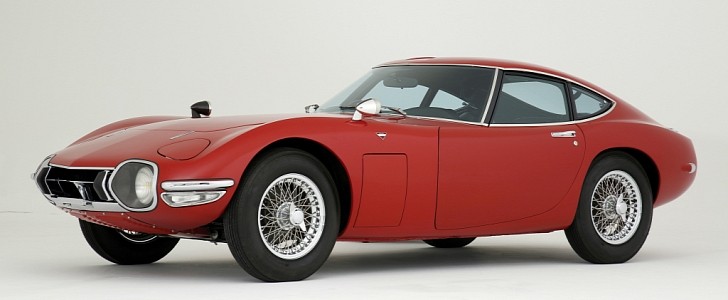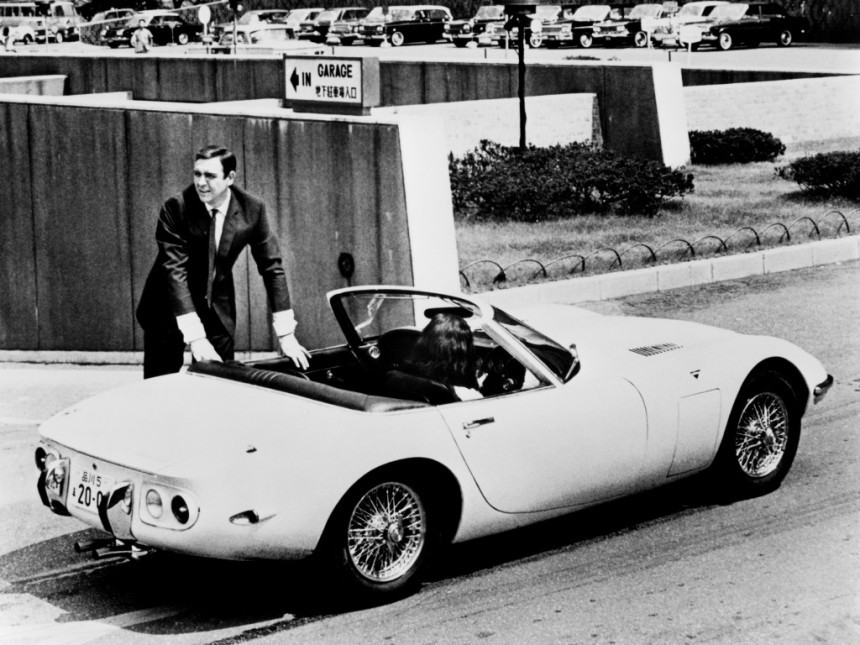Datsun is credited with creating the first Japanese sports car, the S211. Based on a truck chassis and powered by a 1.0L engine, it was hardly a thriller by the standards of that era. The first proper sports car from the Land of the Rising Sun is the Toyota 2000GT, a real looker that changed everybody’s perception about the Japanese automotive industry.
The story of the 2000GT begins in 1964, the year LBJ defeated Republican nominee Barry Goldwater in the presidential election by a landslide and the year Surgeon General Luther Terry published a report about the dangers of smoking. With plenty of help from the Yamaha Motor Corporation, the peeps at Toyota were persuaded that was high time to develop a performance-oriented product that could take on Europe’s sports cars.
Nissan, then known as Datsun in export markets, was originally approached by Yamaha with the concept of a two-seat coupe. The more powerful of the two companies ditched this proposal due to the high costs associated with such a project, costs that were gladly accepted by Toyota.
Most of the development work for the 2000GT was carried out by Toyota, whereas Yamaha was tasked with squeezing every ounce of performance from the engine. Also known for its musical instruments, Yamaha further helped the automotive colossus with the new car’s bodyshell and chassis.
Toyota was perceived as the most conservative automaker in Japan back then, which explains why the high-ranking executives wanted to bring an exciting product to the market as fast as possible. Instead of a mass-produced sports car, Toyota made a tremendous change to Yamaha’s initial plan for the upcoming 2000GT by focusing on quality above all else.
Originally expected to sell in the ballpark of 1,000 examples per month, the Toyota 2000GT actually moved 351 units from 1967 to 1970. “Commercial flop” would be the only acceptable way to describe this result, but in hindsight, the Western world started taking Toyota more seriously.
Take, for instance, the car’s first outing on the silver screen. It was 1966 when Toyota was approached by film producer Albert Romolo "Cubby" Broccoli for the James Bond movie You Only Live Twice starring Sean Connery and Japanese actress Akiko Wakabayashi. The 2000GT was in its final stages of development, and there was a problem in regards to Agent 007.
More to the point, Connery was too big of a guy for the fixed-head coupe. Toyota didn’t want Broccoli to go to some other automaker for a more spacious car, which is why the Japanese company agreed to build a pair of open-top roadster models at the Toyopet Service Centre in Tsunashima.
Only one You Only Live Twice roadster survives, the same car Toyota displayed at the Geneva Motor Show in March 1967. The other one mysteriously disappeared after it had been taken to the UK in the ‘60s.
Another reason why the 2000GT proved to be a good investment for Toyota is motorsport success. A specially-prepped car won the Suzuka 1000 Kilometers in 1966, and the 2000GT came third in the 1966 Japanese Grand Prix.
It also won the 24 Hours of Fuji and Fuji 1000 Kilometers in 1967, and that’s not all. Across 72 hours at the Yatabe Test Circuit in Japan in 1966, a Tosco-tuned 2000GT broke 16 endurance and speed records, averaging 128.76 miles per hour (207.2 kilometers per hour) on the banked oval.
What’s Tosco, you ask? Formed in 1957, Toyota Sports Corner was the motorsport branch that eventually morphed into Toyota Racing Development (TRD) in 1976 in the aftermath of the 1973 OPEC oil crisis.
Underpinned by a Lotus-inspired backbone tube chassis, the 2000GT features independent suspension on every corner, power rack-and-pinion steering, four-wheel power disc brakes, and a straight-six engine based on the M-series lump of the Toyota Crown. Yamaha’s aluminum twin-cam head helped the 2.0-liter mill crank out 150 horsepower at 6,600 revolutions per minute and 129 lb-ft (175 Nm) at 5,000 rpm. A torquier 2.3-liter derivative was also offered, although it made less power due to its SOHC layout.
Of the 351-strong production run, 342 examples of the glorious 2000GT came in MF10 spec with the 3M DOHC engine, whereas the remaining nine vehicles were delivered in MF12 spec with the 2M SOHC powerplant.
Nissan, then known as Datsun in export markets, was originally approached by Yamaha with the concept of a two-seat coupe. The more powerful of the two companies ditched this proposal due to the high costs associated with such a project, costs that were gladly accepted by Toyota.
Most of the development work for the 2000GT was carried out by Toyota, whereas Yamaha was tasked with squeezing every ounce of performance from the engine. Also known for its musical instruments, Yamaha further helped the automotive colossus with the new car’s bodyshell and chassis.
Toyota was perceived as the most conservative automaker in Japan back then, which explains why the high-ranking executives wanted to bring an exciting product to the market as fast as possible. Instead of a mass-produced sports car, Toyota made a tremendous change to Yamaha’s initial plan for the upcoming 2000GT by focusing on quality above all else.
Originally expected to sell in the ballpark of 1,000 examples per month, the Toyota 2000GT actually moved 351 units from 1967 to 1970. “Commercial flop” would be the only acceptable way to describe this result, but in hindsight, the Western world started taking Toyota more seriously.
More to the point, Connery was too big of a guy for the fixed-head coupe. Toyota didn’t want Broccoli to go to some other automaker for a more spacious car, which is why the Japanese company agreed to build a pair of open-top roadster models at the Toyopet Service Centre in Tsunashima.
Only one You Only Live Twice roadster survives, the same car Toyota displayed at the Geneva Motor Show in March 1967. The other one mysteriously disappeared after it had been taken to the UK in the ‘60s.
Another reason why the 2000GT proved to be a good investment for Toyota is motorsport success. A specially-prepped car won the Suzuka 1000 Kilometers in 1966, and the 2000GT came third in the 1966 Japanese Grand Prix.
It also won the 24 Hours of Fuji and Fuji 1000 Kilometers in 1967, and that’s not all. Across 72 hours at the Yatabe Test Circuit in Japan in 1966, a Tosco-tuned 2000GT broke 16 endurance and speed records, averaging 128.76 miles per hour (207.2 kilometers per hour) on the banked oval.
What’s Tosco, you ask? Formed in 1957, Toyota Sports Corner was the motorsport branch that eventually morphed into Toyota Racing Development (TRD) in 1976 in the aftermath of the 1973 OPEC oil crisis.
Underpinned by a Lotus-inspired backbone tube chassis, the 2000GT features independent suspension on every corner, power rack-and-pinion steering, four-wheel power disc brakes, and a straight-six engine based on the M-series lump of the Toyota Crown. Yamaha’s aluminum twin-cam head helped the 2.0-liter mill crank out 150 horsepower at 6,600 revolutions per minute and 129 lb-ft (175 Nm) at 5,000 rpm. A torquier 2.3-liter derivative was also offered, although it made less power due to its SOHC layout.
Of the 351-strong production run, 342 examples of the glorious 2000GT came in MF10 spec with the 3M DOHC engine, whereas the remaining nine vehicles were delivered in MF12 spec with the 2M SOHC powerplant.



























